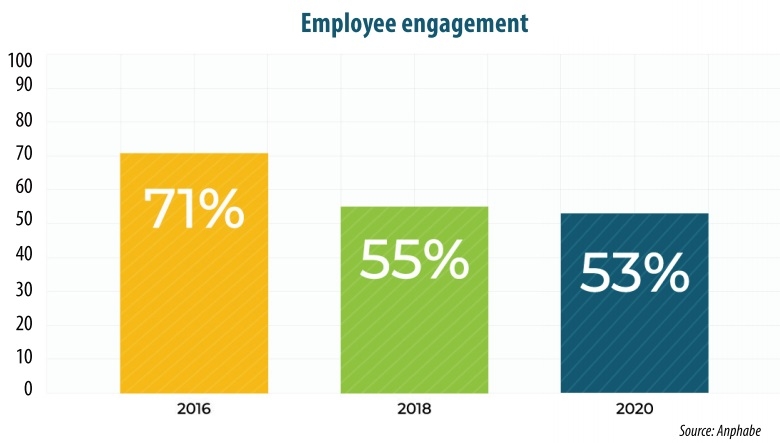Bettering workplaces to retain talent
 |
| Bettering workplaces to retain talent |
According to survey results on trends in human resources (HR) and the working environment carried out by Anphabe, difficulties in the job market in recent years have made it easier for employees to fall into uncertainty and anxiety.
The survey published in March, was carried out from the second quarter to the end of the third quarter of 2020 with 53,000 workers in Vietnam participating.
It shows that many workers expect to receive more attention, commitment, and leadership from business leaders, as well as become more empowered at work to increase the connection between employees and businesses. Some 60 per cent of employees in the survey said they will work harder and stick more closely to business practices if that business prioritises investment and improves operations.
Meanwhile, more than half of the participants do not intend to change jobs but are instead willing to accompany the company to overcome difficulties because they believe in the corporate vision and strategy. This is a reason for businesses to improve, restructure, and increase employee benefits to keep staff stable in the context of the growing labour market.
Protecting rights
For many years in the top 10 sustainable businesses in Vietnam and last year receiving the title of outstanding enterprise for employees, Nestlé Vietnam is one example of a strong working environment for employees. Up to 85 per cent of the total 2,300 employees of the company are satisfied with the salary and benefit policies they are enjoying, and employee resignation rate ranges from 7.3 to 7.8 per cent, according to the company.
Truong Bich Dao, HR director of Nestlé Vietnam, said people are the most important factor for the company. Even in the difficult situation caused by COVID-19, the company has protected employee rights and incomes, raised salaries, and organised training courses for improving skills for employees, at a cost of over $780,000 per year.
Not only affirming to be one of the leaders in implementing optimal personnel policies and the best working environment, Nestlé Vietnam also pioneers commitments on women’s empowerment and gender equality with many activities aimed at the community, contributing to increased sympathy and a deeper connection between employees and businesses.
Nestlé Vietnam is not the only company that understands the importance of this, because in the list of 100 best workplaces in Vietnam over the years is typically the presence of other familiar businesses such as Vinamilk, FPT, Coca-Cola, Honda, Viettel, and SABECO, among others.
FPT strives to build an environment that attracts young and dynamic employees by always encouraging them to create, develop their talents, and support startup projects.
Chu Quang Huy, chief HR officer at FPT Corporation, previously shared, “FPT does not keep people with just salary or a remuneration policy. What we do is offer learning and practice. At FPT, everyone has the opportunity to express themselves, to be able to live as themselves, and to live in an environment of solidarity and teamwork.”
Finding a common voice
Meanwhile, the remuneration policy is not inferior to foreign companies, and the development and nurturing of financial personnel is the secret for Vinamilk to both ensure quality human resources and develop a team of successors for a new stage of development towards the goal of being in the top 30 dairy companies globally.
In addition to businesses that have received the trust of their employees by creating a culture of connection and development, many employees nowadays are also ready to leave their roles after years of working to find a better environment if they are unable to find a common voice on issues related to leadership and rights. There have been cases where employees organised mass resignations or sued the company when they felt their rights and interests were not respected.
The results of Anphabe’s Human Resources Happiness survey over the years show that Vietnamese employees are less and less attached to any one company, and this decline has been seen continuously over the past five years, from 71 per cent in 2016 to 53 per cent by 2020.
Up to 35 per cent intend to change jobs within the next year, an increase of 11.1 per cent compared to 2018. Just over 7 per cent of this group are employees who have made efforts but still want to leave, while the remaining 28 per cent belongs to employees who do not put in effort and actually cherish the intention to change jobs.
What the stars mean:
★ Poor ★ ★ Promising ★★★ Good ★★★★ Very good ★★★★★ Exceptional
Themes: Human Capital 4.0
Related Contents
Latest News
More News
- PM orders investment model for North–South high-speed rail (December 22, 2025 | 17:43)
- First members of Danang International Finance Centre revealed (December 22, 2025 | 17:39)
- Securing capital and efficiency for Vietnam’s 2026-2030 growth ambitions (December 17, 2025 | 10:00)
- Driving double-digit growth through green and circular transformation in Vietnam (December 17, 2025 | 09:00)
- Vietnam bucking trend in the global M&A landscape (December 16, 2025 | 14:20)
- Vietnam’s green transition demands collective financial action (December 15, 2025 | 12:00)
- VIR workshop highlights capital and policy for sustainable development (December 15, 2025 | 11:00)
- National Assembly approves pilot mechanisms to accelerate major projects in Hanoi (December 12, 2025 | 11:29)
- Vietnam eases policy approval requirements, simplifies foreign and outbound investments (December 11, 2025 | 17:53)
- Unpacking new momentum in Vietnam’s M&A market (December 10, 2025 | 09:59)

 Tag:
Tag:





















 Mobile Version
Mobile Version